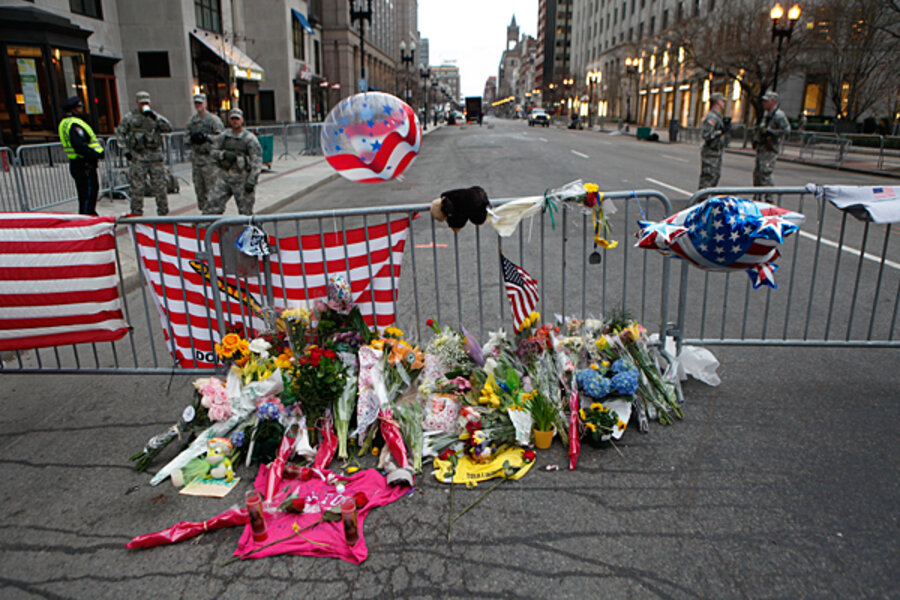Boston Marathon bombing: '6L' mark, circuit boards may be key clues
Loading...
Federal agents are quickly determining how the Boston Marathon bombing was carried out, but the question of who is responsible remains a mystery as the investigation into the deadly attack scours a massive crime scene for answers.
Under the direction of the FBI, more than 1,000 law enforcement officers are going over every inch of a large portion of Boston’s Back Bay in an effort to find every scrap that might possibly represent a physical clue, said FBI Special Agent in Charge Richard DesLauriers at a Tuesday evening briefing. They’re interviewing every eye witness they can find and matching evidence with existing law enforcement databases.
Both of the bombs were packed in heavy, dark bags, probably duffel bags or backpacks, said Mr. DesLauriers. He asked anyone who had seen a person struggling with such a load near the marathon's finish line on April 15, or anyone who had heard a friend, relative, neighbor, or coworker talk about targeting the iconic race in any way, to call the FBI.
“Someone knows who did this. Cooperation from the community will play a crucial role in this investigation,” said DesLauriers.
Two blasts ripped through the Back Bay crowd seconds apart on Monday just before 3 p.m. Early indications are that the bombs had a basic explosive element, such as gunpowder or residue from match heads, placed inside common pressure cookers. Nails or ball bearings were added to create shrapnel.
Pictures from a law enforcement bulletin obtained by the Associated Press and Reuters showed pictures of mangled pressure cooker scraps, scraps of black nylon, a circuit board, and a battery with wires attached.
DesLauriers declined to speak publicly about this evidence. But news reports indicate that the FBI believes it may have recovered enough physical remains of the bombs to start the crucial business of reconstructing where parts came from and how they were assembled.
According to The New York Times, one of the pressure cooker scraps is inscribed “6L,” for six-liter capacity. The Spanish company Fagor is one firm that makes cookers identified with such a stamp. It sells 50,000 of them in the US every year, the Times reported.
At least some of the nails in the bombs were tiny, the size of picture-hanging nails or brads, according to NBC News.
A witness has provided WHDH, an NBC affiliate in Boston, with two photos that may help determine where and how one bomb was positioned, among other things.
The first photo shows a dark bag next to a mailbox and barricade along the marathon route. The second shows no bag, and injured people and debris blown about the scene.
“A man took the images from his office above Boylston Street and they show the moments right after one of the explosions,” wrote WHDH reporter Susan Tran.
Currently the FBI has no suspects or live leads on a suspect or suspects in the case. A Saudi native questioned in a hospital after the attack appears to have been a frightened spectator. An FBI search of an apartment in suburban Revere on Monday evening appears to have produced no connections to the bombing.
The relatively crude nature of the bombs indicates that it’s likely no sophisticated terror network was involved in the actual attack, according to some experts. The attack points to a “lone wolf” actor who constructed the bomb from instructions readily available on the Internet, including a how-do from Inspire, the English-language magazine of Al Qaeda in the Arabian Peninsula.
Flash powder or an explosive sugar chlorate mixture might have been the bombs' main ingredient, according to an unnamed expert quoted by CNN. That would explain the yellowness of the flame, as shown in video and photos of the event.
Higher-quality military explosive is usually gray or black, said the expert.
Other evidence pointing toward the lone wolf theory includes the fact that no one has yet taken responsibility for the bombing. Organized groups usually do boast about the act – that’s how they spread the “terror” in “terrorism,” after all. But aggrieved individuals, whatever their motivation, are more unpredictable.
Law enforcement officials say it is possible that a lone wolf could be either a domestic terrorist moved by domestic concerns, as was Oklahoma City federal building bomber Timothy McVeigh, or an individual radicalized by Islamist terror teachings. While some aspects of the attack might indicate the latter – two explosions are widely used in Middle East bombings, for instance – the ubiquity of information about bombings means anyone could have picked up such techniques from the Internet with little effort.
Scores of victims of the marathon explosions remain hospitalized. The blast killed 8-year-old Martin Richard after he congratulated his father, who had run in the race. On Tuesday family members identified Krystle Campbell, a young woman from nearby Medford, Mass., as one of the fatalities in the attack. A state-run Chinese newspaper identified the third victim as Lu Lingzi, a Chinese native and graduate student at Boston University.
Boston Police Commissioner Ed Davis said the police presence at the race finish line had been increased for 2013, due to the realization that crowds in the area had grown from past years.
“There was no specific threat about this event,” said Commissioner Davis.
In an indication of the jitters the attack has spread throughout the nation, a United Airlines flight to Chicago returned to the gate Tuesday after passengers became alarmed that two people were speaking a foreign language, the Boston Globe reported. Bags were rescreened before the airliner departed.
[Editor's note: The original version of this story misspelled Krystle Campbell's first name.]








